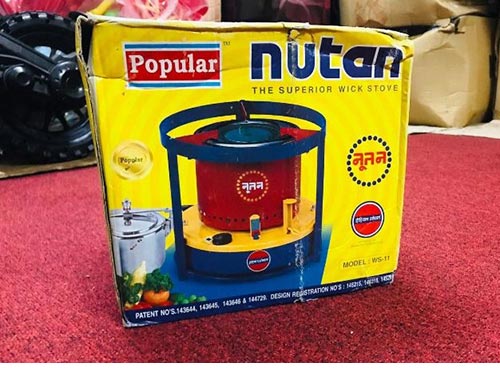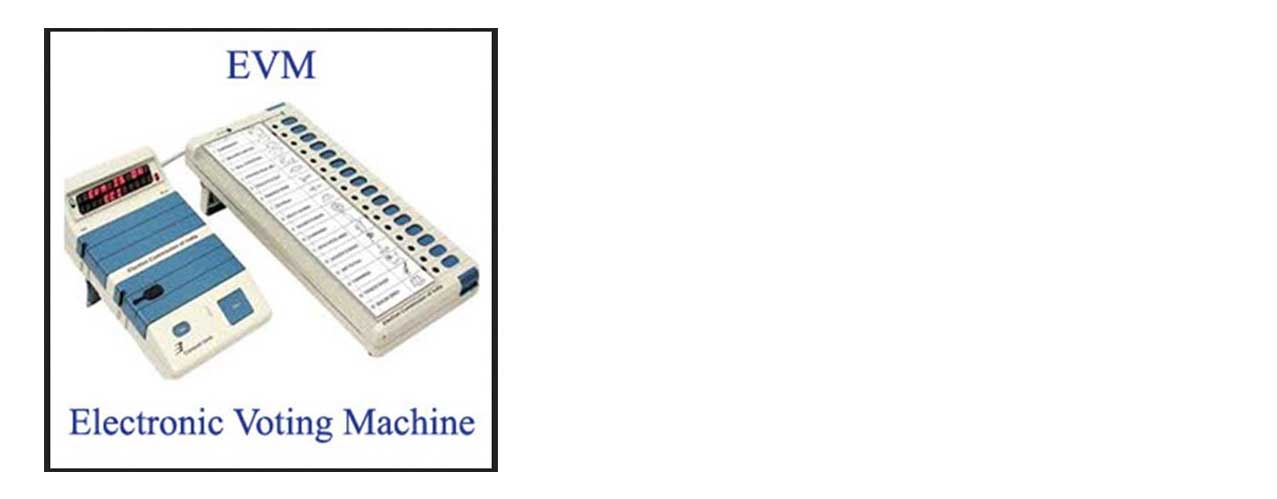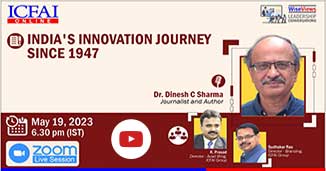India's Innovation Journey Since 1947
On Friday, May 19, we had a very interesting session by Dr Dinesh Sharma. Dr Sharma spoke about “India's Innovation Journey Since 1947”. The entire session can be accessed on the following link:
About Dr Dinesh C Sharma
Dr Dinesh C Sharma is an award-winning journalist, author, and media trainer with over 35 years of experience in reporting on science and technology, health and environment for national and international media. Dr Sharma has been the Science Editor at Mail Today (India Today Group) from 2007 to 2014 and Founding Managing Editor at India Science Wire from 2017 to 2019. He is a regular contributor to the medical journal, The Lancet. In June 2008, he became the first Asian journalist to go to the Arctic to report on an ongoing international scientific expedition relating to climate change.
Among Dr Sharma's major books is The Outsourcer: The story of India's IT revolution, published by MIT Press, USA in 2015. The book was awarded the prestigious Computer History Museum Book Prize instituted by the American Society for History of Technology (SHOT) in 2016. He has also penned a science travelogue – Witness to the Meltdown (Vigyan Prasar, 2015) – based on his climate change reportage from the Arctic in 2008. His latest book– Indian Innovation, Not Jugaad (Roli Books) – is about 100 innovations that have transformed India in the past 75 years. As the Jawaharlal Nehru Fellow (2020-2021), he is working on the evolution of Hyderabad as a technology cluster. The book is slated for publication in 2023.
Dr Sharma's academic experience includes teaching a course in development journalism for MA students at Ateneo de Manila University, Philippines and being a teaching Fellow at the Jawaharlal Nehru University. He is a doctorate from Banaras Hindu University (BHU) and a post-graduate from Osmania University.
India's transformation
Since independence, India has come a long way as the following table indicates.

What explains this remarkable progress?
Various factors could be at play:
- Planning? Planning in India began in 1938.
- Science and technology? Prime Minister Nehru and his successors emphasised the importance of science and technology in economic development.
- Progressive economic policies?
- International/foreign aid?
- Large projects - big dams etc?
- Public Sector Units- heavy engineering, steel plants?
While all these factors did play a role in India's development, we are probably underestimating the role of innovation in our progress since 1947.
Notions about innovation
The common notion is that innovation is:
- Technology-led and more specifically in recent years, digital technology driven.
- Industry or entrepreneurship driven.
- Dependent on Institutional frameworks.
- Driven by for profit enterprises, not public institutions, with non-profits considered incapable of innovation.
- Dependent on markets for dissemination.
But India has demonstrated that innovation:
- Need not be technology-led. Marketing and unique ways of service delivery can also lead to innovation.
- Can go beyond digital technologies.
- Can occur outside institutional frameworks: Industry, startups, government, non-profits, citizens can also contribute.
- Can be enabled by social, people-centric dissemination, not just market-centric.
- Is a combination of technology, policy, marketing, packaging.
- Responds to societal needs and may not be profit driven.
Case studies of Indian innovation
STD/ISD booths
In the 1980s and early 1990s, most Indians were handicapped by the absence of telephone lines in their homes. The waiting line was very long. It would take years to get a phone connection.
CDOT (Centre for Development of Telematics) came up with a rural telephone exchange that would work even at high temperatures. Sam Pitroda played a major role in the development of these exchanges.
It was politically difficult to break the monopoly of Department Of Telecommunications. But the government realized that last mile delivery could be privatized. Manned booths were needed in a country like India with low literacy levels.

So private entrepreneurs who could set up STD/ISD telephone booths were given preferential allocation of telephone lines. Thus, the innovation was in franchising. ISD/STD booths became very popular and continued to be so even after cell phones began to proliferate. People would come to these booths for internet access. This innovation has spread to other parts of the world, especially Africa.
The NUTAN stove
The energy shock of the early 1970s and the rise in oil prices led to the need for energy conservation. Most India kitchens ran on kerosene stoves. Supported by the National Institute of Design and Indian Oil Corporation, a superior wick stove was designed that would consume less kerosene. This stove become very popular and was used all over the country. In fact, till about 10 years back, it was still being used.

The mid-day meals scheme
In the 1980s, the need of the hour was to drive up the literacy rate which meant higher school enrolments. First introduced by Chief Minister Kamaraj in Tamil Nadu, the mid-day meal scheme in schools played an important role in encouraging children to attend school and arrest the dropout rate. It was a much better alternative to giving people subsidies to eat food at home. This was a political innovation.
Responding to a question later in the session, Dr Sharma felt that reservation is not a political innovation. It is more of a constitutional guarantee. However, the Lok Adalat can be considered one.
Electronic voting machines
EVMs were a response to the menace of booth capturing during elections. They were pioneered under Chief Election Commissioner (1977-82) Mr SL Shakdher, who requested the Hyderabad based ECIL to develop EVMs. India introduced electronic voting machines (EVMs) in 1982. Prior to the introduction of electronic voting, India used paper ballots and manual counting. The paper ballots method led to fraudulent voting and booth capturing, where party loyalists captured booths and stuffed them with pre-filled fake ballots. The printed paper ballots were also more expensive, requiring many people to count hundreds of millions of individual ballots.

Note: There are buttons on the EVM for each party. All that the voters have to do is to press the right button. The EVMs have basic functionality but are not connected to the internet and do not have Wi-Fi/Bluetooth capabilities. So these machines cannot be hacked.
It is also difficult to preprogram the machine to rig the results in favor of any party. The list of candidates in each constituency and the order in which they appear is not known beforehand. It is finalized only two weeks before the elections. By this time, the EVMs have already left the factory in sealed condition and cannot be tampered with.
EVMs also prevent booth capturing. Each EVM can take about 1000 votes. An EVM can record the press of a button only once every 12 seconds. If the buttons are pressed more frequently as antisocial elements capturing poll booths can be expected to do, the EVM will not register any votes. Any person who tries to capture a booth and begins to press the button of his/her party will take 3.5 hours to press the button 1000 times.
EVM was meant to do away with paper. But the constant clamour against EVMs by losers prompted the Election Commissioner to introduce a paper trail using a printer. This is technically called Voter Verified Paper Audit Trail. As the printout falls through a small glass window, voters can see for themselves that they have pressed the right button. The billion odd slips that are generated in the elections are basically a waste of paper. They are taken out and examined only if there is a dispute at the time of counting.
EVM is a great example of appropriate technology for Indian conditions. It is an innovation which India can be proud of. Other countries too can learn from India's experience.
STPI
Software Technology Parks of India was set up in 1991 as an autonomous society under the Ministry of Electronics and Information Technology. STPI's main objective has been the promotion of software exports from the country. STPI acts as a single-window in providing various services to the software exporters.
In the early days of the Indian IT industry most companies were operating from their homes or small rented premises. There were no telephone lines or satellite connections. So how could software be shipped to foreign clients? Texas Instruments demonstrated the use of satellite links. But then it was a large company with a lot of resources.
Modelled on the Research triangle Park, STPI came as a welcome move. STPI was different from SEPZ (in Mumbai) which was suited for manufacturing companies. STPI provided data links and other shared infrastructure. Customs clearance also became easy and unnecessary paperwork was eliminated. Except for TCS, all the major Indian IT services companies were incubated in STPI.
The services provided to the software exporting community include statutory services, data communications services, incubation facilities, training, and value-added services. STPI has played a key developmental role in the promotion of software exports with a special focus on SMEs and startups.
Cheap medicines
Indian pharma companies like Cipla and Shantha Bio tech have played a big role in reducing drug prices and making them affordable globally. Thanks to their efforts, diseases like AIDS and Hepatitis B could be controlled. The patent law of 1971 which recognized process patents was a major game changer. The government labs began to develop new processes. The drug companies began to manufacture the drugs using these processes. Till 2005, when product patents came back, the pharma industry grew impressively and succeeded in making drugs affordable for the common man.

Responding to a question, Dr Sharma added that even though process patents have gone away, there are still big opportunities for Indian pharma in case of drugs going off patent. He also felt that the efforts of Indian pharma should not be dismissed as reverse engineering. It involves the development of sophisticated processes and investment in appropriate manufacturing facilities that can maintain the required quality.
Electronic payments and UPI
The National Payments Corporation of India (NPCI) is an umbrella organization for operating retail payments and settlement systems in India. It is an initiative of the RBI and the Indian Banks Association under the provisions of the Payment and Settlement Systems Act, 2007, for creating a robust Payment & Settlement Infrastructure in India. NPCI initially enabled the transfer of money using SMS through feature phones. When smart phones arrived, NPCI transformed the landscape with UPI.
The Egg Revolution
The revolution was pioneered by Mr BV Rao who set up Venkateshwara Hatcheries, which became the VH Group. Thanks to his efforts, the National Egg Coordination Committee was set up. Earlier, prices varied across the country. There were cartels and hoarding. Mr Rao encouraged poultry farmers to push eggs into regions where the prices were high. For this to happen, timely information from regions across the country was needed. This was enabled by the ISD/STD booths. So instead of the government imposing price restrictions, it became a model of self-regulation through farmer unions.
Aravind Eyecare Model
Dr G. Venkataswamy set up Aravind Eye Hospital which pioneered the factory model. Aravind is known for its efficient and high-volume cataract surgeries. Aravind has developed a system where surgeries are performed in assembly-line fashion, ensuring maximum efficiency while maintaining quality standards. This enables Aravind to perform many surgeries and provide affordable eye care to a large number of patients.
The Sachet Revolution
Earlier, only solid items like tea was sold in sachets. But the Tamil Nadu entrepreneur, Mr Chinni Krishnan demonstrated that liquid shampoo could also be sold in sachets. For low-income workers, shampoo in bottles was unaffordable. Sachets enabled them to meet their aspirations.
Note: Mr Chinni Krishnan would buy pharmaceuticals in bulk, repack them in smaller sizes and then sell to pharma shops. Once while travelling to Singapore, the shampoo bottle Mr Krishnan was carrying in his suitcase broke and spoiled all his clothes. Instead of complaining, he looked at it as an opportunity. He applied the principle of his pharma business to shampoos. That is how Velvette shampoo was born. He made his own packing machine and offered the shampoo in small affordable packets or sachets that even poor people could afford. Mr Krishnan's philosophy was what the rich people could enjoy, poor people should also be able to afford. The Velvette shampoo was later voted as one of the 50 revolutions which changed post-independence India.
Chota Recharge
The idea was the same was in case of sachets, i.e. making a service more affordable. The ability to recharge their cell phones in small amounts fuelled the mobile revolution.
New institutions
A good example is the PPP (Public Private Partnership) model. Many national labs were set up as a partnership between the government and industrialists. IIM Ahmedabad was the result of a partnership between the Ahmedabad Education Society, central government, state government and industrialists like Kasturbhai Lalbhai. Dr Vikram Sarabhai was also involved in the setting up of IIMA.
Concluding remarks
What are the lessons we can learn from innovation in India? We need to look at innovation with a different lens. It often involves the frugal use of technology, addresses societal needs, is disseminated organically, and has a wider use going beyond India. The state's role in enabling innovation continues to be important. UPI is an excellent example. Some of the less talked about innovations have had major ramifications across the country.
Q&A
It is difficult to pinpoint specific areas. However, we can expect innovations that will address the needs of society, either explicit or latent. India is a country where many basic needs are yet to be fulfilled. The people are looking for cheap and accessible products and services. So, the opportunities to innovate are plenty. With the academia playing a more active role, the future of innovation in the country is bright.
Talking specifically about the defence sector, Dr Sharma felt that opportunities will open in areas like space. Instead of using large satellites, we may use constellations of microsatellites. Applications developed for defence may also find use in the civil sector.
Responding to another question, Dr Sharma felt that more than technology per se, what is more important is the application. Thus space tech is important but it is the application of space tech which is more important. We must build capacity to leverage emerging technologies to our advantage.
Innovation is context specific. For example, Brazil was an open economy much before India. Cross fertilization of ideas is certainly possible though blind emulation is difficult. Many MNCs are looking at India as a laboratory. They are developing products in the country and taking them global. The Aloo Tikki burger of McDonald's is a good example.
India's young population is a major competitive advantage provided they are skilled properly. We succeeded in IT only because of the availability of manpower. In sectors like medical tourism, hospitality and elderly care, there are exciting opportunities. But to exploit the opportunities, we must invest in skilling our youth.
Collaboration is certainly important, but it cannot be engineered. It should evolve in an organic fashion. The roles of different stakeholders must be reinvented. For example, it is still difficult for an Indian professor to become a board member of a company. We cannot transplant institutions. Rather, we should create an enabling environment and allow connections and networks to develop. Just by transplanting an institute, you cannot create a Silicon Valley. We may have to work on creating Indian MIT (and not MIT in India), just like IIT Kanpur.
A lot of research is going on. India has a presence but can do more. Quite a bit of the research going on is multidisciplinary involving many institutions.
A course on innovation can certainly not create innovators. Similarly by merely studying a course on entrepreneurship, one doesn't become an entrepreneur. The mind of the innovator is different. Innovators respond to a felt need. They have a keen desire to solve a problem. Dr Sharma gave the example of a child who developed a walker with adjustable legs as her grandmother had fallen and hurt herself while moving around with a walker. A scientist in Bangalore developed a chemical to apply on the skin while spraying pesticides. He had seen farmers in his village spraying pesticides without any protective gear.
Many of the innovations listed by Dr Sharma are difficult to patent. A few like Nutan stove were patented as it is easier to patent products. Some innovators like to patent. Others are ok to share their inventions with others. But the focus on filing patents is increasing.
Whenever a new technology arrives, there is scepticism. When the automobile arrived, people felt that horses were good enough. We must learn to engage with any new technology and learn how to benefit from it.
The proportion of intense tropical cyclones is expected to increase on a global scale with increasing global warming, thus increasing the vulnerability of growing coastal populations. The probability of compound flooding (storm surge, extreme rainfall and/or river flow) has risen in some locations and will continue to increase due to both sea level rise and more intense precipitation. Concurrent heatwaves and droughts are likely to become more frequent, with the associated risk of wildfires.
While arresting climate change is important (through measures such as reducing emissions) helping people to adjust is also important. The hills and the coastal areas are the most affected by climate change. NGOs can play a big role by enabling the locals to embrace new technologies, training them appropriately and collecting data.

